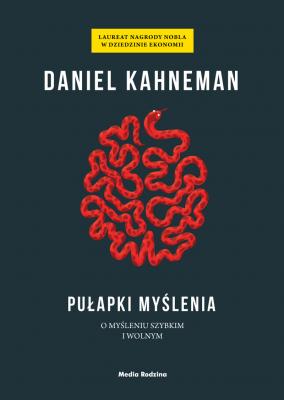Pułapki myślenia. Daniel Kahneman
Читать онлайн.| Название | Pułapki myślenia |
|---|---|
| Автор произведения | Daniel Kahneman |
| Жанр | Общая психология |
| Серия | |
| Издательство | Общая психология |
| Год выпуска | 0 |
| isbn | 9788372787101 |
41
nie jest tylko zwykłą metaforą: Matthew T. Gailliot i in., Self-Control Relies on Glucose as a Limited Energy Source: Willpower Is More Than a Metaphor, „Journal of Personality and Social Psychology” 92 (2007), s. 325‒36; Matthew T. Gailliot i Roy F. Baumeister, The Physiology of Willpower: Linking Blood Glucose to Self-Control, „Personality and Social Psychology Review” 11 (2007), s. 303‒27.
42
skutki wyczerpywania się ego: Gailliot, Self-Control Relies on Glucose as a Limited Energy Source.
43
Niepokojący wpływ wyczerpania na podejmowane oceny: Shai Danziger, Jonathan Levav i Liora Avnaim-Pesso, Extraneous Factors in Judicial Decisions, „PNAS” 108 (2011), s. 6889‒92.
44
intuicyjną odpowiedź, która jest przekonująca – i błędna: Shane Frederick, Cognitive Reflection and Decision Making, „Journal of Economic Perspectives” 19 (2005), s. 25‒42.
45
uznaje ten sylogizm za poprawny: Ten systematyczny błąd znany jest pod nazwą „błędu przekonania” (belief bias). Por. Evans, Dual-Processing Accounts of Reasoning, Judgment, and Social Cognition.
46
nazwałby ich bardziej racjonalnymi: Keith E. Stanovich, Rationality and the Reflective Mind (Nowy Jork: Oxford University Press, 2011).
47
przed okrutnym dylematem: Walter Mischel i Ebbe B. Ebbesen, Attention in Delay of Gratification, „Journal of Personality and Social Psychology” 16 (1970), s. 329‒37.
48
„Gabinet nie zawierał zabawek […] niepokojące objawy”: Inge-Marie Eigsti i in., Predicting Cognitive Control from Preschool to Late Adolescence and Young Adulthood, „Psychological Science” 17 (2006), s. 478‒84.
49
wyższe wyniki w testach na inteligencję: Mischel i Ebbesen, Attention in Delay of Gratification; Walter Mischel, Processes in Delay of Gratification, w: „Advances in Experimental Social Psychology”, Vol. 7, red. Leonard Berkowitz (San Diego, CA: Academic Press, 1974), 249‒92; Walter Mischel, Yuichi Shoda i Monica L. Rodriguez, Delay of Gratification in Children, „Science” 244 (1989), s. 933‒38; Eigsti, Predicting Cognitive Control from Preschool to Late Adolescence.
50
efekt utrzymywał się przez kilka miesięcy: M. Rosario Rueda i in., Training, Maturation and Genetic Influences on the Development of Executive Attention, „PNAS” 102 (2005), s. 14931‒36.
51
konwencjonalne miary inteligencji: Maggie E. Toplak, Richard F. West i Keith E. Stanovich, The Cognitive Reflection Test as a Predictor of Performance on Heuristics-and-Biases Tasks, „Memory & Cognition” (w przygotowaniu).
52
Maszyneria skojarzeniowa: Carey K. Morewedge i Daniel Kahneman, Associative Processes in Intuitive Judgment, „Trends in Cognitive Sciences” 14 (2010), s. 435‒40.
53
nie miałeś nad tym żadnej kontroli: Dla uproszczenia nie wspominam w tekście, że dochodzi wtedy również do rozszerzenia źrenicy. Źrenica rozszerza się zarówno w chwilach pobudzenia emocjonalnego, jak i pobudzenia towarzyszącego wysiłkowi intelektualnemu.
54
myślimy ciałem: Paula M. Niedenthal, Embodying Emotion, „Science” 316 (2007), s. 1002‒1005.
55
PIĆ toruje ideę WODY: Analogią dla tego obrazu może być pompowanie wody ze studni. Pierwsze ruchy rączką nie dają wody, jednak tylko dzięki nim woda może płynąć po wykonaniu kolejnych ruchów.
56
„znajduje – on – to – żółty – natychmiast”: John A. Bargh, Mark Chen i Lara Burrows, Automaticity of Social Behavior: Direct Effects of Trait Construct and Stereotype Activation on Action, „Journal of Personality and Social Psychology” 71 (1996), s. 230‒44.
57
słowa związane z podeszłym wiekiem: Thomas Mussweiler, Doing Is for Thinking! Stereotype Activation by Stereotypic Movements, „Psychological Science” 17 (2006), s. 17‒21.
58
The Far Side: Fritz Strack, Leonard L. Martin i Sabine Stepper, Inhibiting and Facilitating Conditions of the Human Smile: A Nonobtrusive Test of the Facial Feedback Hypothesis, „Journal of Personality and Social Psychology” 54 (1988), s. 768‒77.
59
przykre zdjęcia: Ulf Dimberg, Monika Thunberg i Sara Grunedal, Facial Reactions to Emotional Stimuli: Automatically Controlled Emotional Responses, „Cognition and Emotion” 16 (2002), s. 449‒71.
60
wysłuchanie wiadomości: Gary L. Wells i Richard E. Petty, The Effects of Overt Head Movements on Persuasion: Compatibility and Incompatibility of Responses, „Basic and Applied Social Psychology” 1 (1980), s. 219‒30.
61
zwiększeniem finansowania szkolnictwa: Jonah Berger, Marc Meredith i S. Christian Wheeler, Contextual Priming: Where People Vote Affects How They Vote, „PNAS” 105 (2008), s. 8846‒49.
62
przypominanie ludziom o pieniądzach: Kathleen D. Vohs, The Psychological Consequences of Money, „Science” 314 (2006), s. 1154‒56.
63
atrakcyjność idei autorytarnych: Jeff Greenberg i in., Evidence for Terror Management Theory II: The Effect of Mortality Salience on Reactions to Those Who Threaten or Bolster the Cultural Worldview, „Journal of Personality and Social Psychology” 58 (1990), s. 308‒18.
64
W oryginale „W _ _ H” i „S _ _ P”, które można uzupełnić zarówno jako „WASH” (myć) i „SOAP” (mydło), jak i np. „WISH” (życzenie) czy „SOUP” (zupa) (przyp. tłum.).
65
„efektem Lady Makbet”: Chen-Bo Zhong i Katie Liljenquist, Washing Away Your Sins: Threatened Morality and Physical Cleansing, „Science” 313 (2006), s. 1451‒52.
66
częściej wybierały płyn do płukania ust niż mydło: Spike Lee i Norbert Schwarz,
